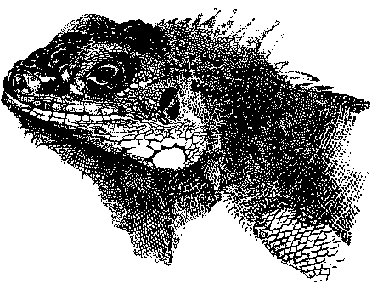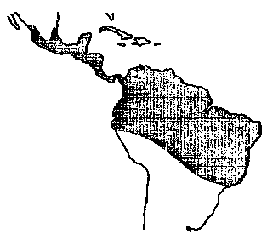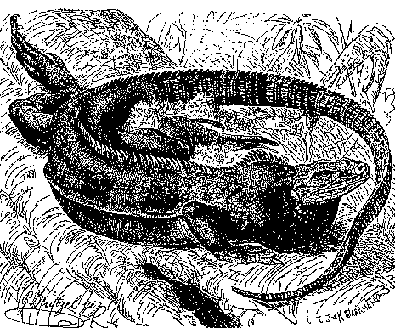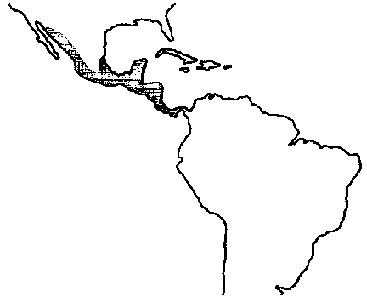Part VI: Lizards[edit | edit source]
Large lizards have been important foods since prehistoric times and are still commonly hunted in parts of Asia, Africa, and Latin America.1 Some (such as the monitor lizards seen in markets in Indochina) are carnivorous species that may be difficult to feed and raise economically. However, the iguanas of the Americas offer promise as microlivestock. They are herbivorous and feed primarily on leaves, flowers, and fruits, including many that are too high in the trees to be gathered by man or by other livestock.
Iguana meat is popular throughout much of Latin America, where consumers willingly pay more for it than for fish, poultry, pork, or beef. To fill the demand, several iguana species are hunted by rifle, slingshot, trap, and noose; they are even run down by trained dogs. Villagers (often small children) catch them for food for the family; professional hunters snare and sell them to vendors. Iguanas are hauled around in gunny sacks and wicker baskets by car, boat, horseback, and people on foot. In parts of El Salvador they have been known to arrive at the market by the truckload.
As a result of this indiscriminate hunting, iguanas are now steadily becoming more scarce, and the destruction of their habitat makes the situation even worse. At present, many parts of Latin America's tropical forests are being cleared. The green iguana in particular depends on trees, and as forests disappear its populations are destroyed.
However, iguanas are forest-edge species: they will grow well on ranches and farms as long as patches of trees are left standing. This offers the hope that they can be raised as microlivestock. They reproduce so prolifically that, in principle, populations can build up exponentially. Mature females, for example, may produce 30 or more eggs a year for up to 10 years.
In the past few years, a notable research program in Panama and Costa Rica (see page 351) has laid the practical foundation for iguana farming. It has artificially incubated and raised thousands of green iguana hatchlings. With less than half a square meter of living space per animal, the hatchlings have grown as fast or faster than their wild counterparts. Unlike their kin in the wild - which in their first year of life suffer 95 percent mortality from birds, snakes, and other predators- the captive-raised iguanas show almost 100 percent survival. This research project demonstrates that ranching iguanas both for food or for repopulating depleted habitats is feasible. In addition, experimental projects for farming green iguanas have begun in Curacao and El Salvador.
As livestock, lizards have advantages. Being cold-blooded they do not carry human diseases (except for those such as salmonella that result from gross mismanagement). They can be kept in captivity in fairly high densities without diseases breaking out. Although often aggressive in the wild, they coexist in dense populations with few problems as long as they are well fed.
There is an important conservation component as well. Farming these lizards may help check and may even reverse the downward trends of their populations by allowing large numbers to be released back to the wild at a size that inhibits predators.
There are three alternatives for utilizing iguanas:
- To manage wild stocks as game animals;
- To raise iguanas on farms, like chickens and pigs; or
- To raise young iguanas in captivity and then release them into the wild where they can grow to full size and later be harvested on a sustainable basis.
Although the green iguana has so far received the most attention, two other Latin American species are in farming trials. Black iguanas (garrobos) are being raised experimentally in El Salvador and Costa Rica. And the omnivorous tegu lizard, which produces a valuable leather, is beginning to be farmed in Argentina and is briefly described opposite. Both iguana species are described in the following chapters.
TEGU
The tegus (Tupinambis rufescens and T. teguixin) are large lizards of South America. They are highly prized for their skins, which are made into leather for handbags and similar items. Tegus are heavily exploited; on average, Argentina exports over one million skins a year - about $15 million worth. The 50-year-old tegu industry is estimated to support as many as 30,000 people, including tannery employees and people in rural areas who hunt the lizards full- or part-time. Poor agricultural conditions make farming difficult in the Chaco, and sale of a single tegu skin is worth more than a day's wages for a farmband. Some families also eat the tegu meat and use the fat for medicinal purposes. In many areas, the populations have already been driven to the verge of extinction. Husbandry, therefore, could be beneficial. Traders are hoping that captive operations run by families can eventually replace hunting.
Although usually associated with the arid regions of northern Argentina and Paraguay, the tegu's range actually covers much of South America - as far north as Colombia, including Trinidad and the Amazon basin. One species (T. rufescens) normally occurs in a dryland habitat, such as Argentina's Chaco region. It can occur in great numbers in pastures, probably because of the insects associated with cattle. But it also occurs in areas that are unsuitable for cattle. Some places where tegus are common are so dry that they can carry only a single cow in 10 hectares. There, farmers might find it profitable to raise tegus. This would maintain the native biological diversity while perhaps reducing the soil degradation that cattle cause.
The other species (T. tegubixin) occurs in wet forests, such as those found in Argentina's Formosa Province.
Tegus are scientifically interesting. Little is known about their biology, and basic studies are needed. They are not much eaten, but in some areas the tail is considered a delicacy. Indeed, deteriorating economic conditions are already making them more important as a food resource. Convincing campesinos that they can increase their cash income and their meat production by rationally exploiting these large lizards should not be difficult.
Sustainable exploitation could also benefit tegu conservation. Large populations still exist in some areas in Argentina and Paraguay, but, overall, the species are declining. A welldesigned management project could ensure the maintenance and reestablishment of large populations where numbers have drastically decreased.
33 Green Iguana[edit | edit source]
As noted, the green iguana (Iguana iguana) is consumed throughout Central America. It is already subject to heavy commercialization and its populations are plummeting. This is not likely to change: as human population increases, so does demand for iguana meat and eggs as well as for live iguanas, thousands of which are kept as house pets.
Because of its herbivorous diet, inoffensive nature, and high reproductive potential, this reptile is a prime species for intensive management. Alert, curious, and social, it is easily tamed from birth. Given minimal protection during the reproductive season, large populations can build up, and animals can be maintained in simple facilities.
However, although iguanas can be maintained as microlivestock, they may require three years to reach market size. Raising them to maturity entirely under captive conditions is thus probably uneconomic at present, when specimens can still be inexpensively (albeit often illegally) harvested from the wild. However, it has been found that if released into the wild, most will remain in nearby trees, especially if people erect simple feeding stations and keep them stocked with table scraps or weedy vegetation. This makes for very low-cost production during the years of waiting.
Given such findings, iguana farming has a promising future. With research, growth rates can undoubtedly be increased and maintenance costs reduced. Also, iguanas are becoming more valuable each year. Even now, farming them could be economic in some areas where wild iguanas are scarce, especially if the young are released into forested sites when they have grown to a size where mortality is low.
Although green iguanas will happily graze pastures, they need trees. Iguana farming, therefore, provides a way to keep tropical forests standing while still providing people with meat and income. By growing lizards, farmers don't have to fell the forests to create space for growing food crops or cattle. Iguana farming thus gives an economic incentive to preserve the beleaguered tracts of remaining trees. It may even render reforestation economically attractive. And it may promote the use of shelterbelts and contour strips of trees in cattle-ranching areas. Today's researchers estimate that 200-300 kg of meat can be produced per year per hectare from iguanas.
APPEARANCE AND SIZE
The green iguana can grow to more than 2 m long, but more than half of that length is in its whiplike tail. Adults of breeding size generally weigh 2-4 kg. The scaly skin is green, yellowish, or golden brown with dark markings; color is a function of age and reproductive stage.
DISTRIBUTION
This large lizard is indigenous to a vast region stretching from Mexico to northern Brazil and Peru, including a number of Caribbean islands. In Mexico, it occurs in tropical forests along both coasts.
STATUS
Green iguanas were formerly abundant throughout Central America, but no longer. In the mangrove forests along Mexico's Pacific coast, for instance, only 5 percent of the former population remains. In Guatemala's Pacific lowlands, mere remnants are left. In El Salvador's jungles, the animals have declined to 1 percent of their former density. And in both Panama and Costa Rica, the species is now officially classified as endangered.
HABITAT AND ENVIRONMENT
The green iguana usually lives near water in tropical lowland forests. It thrives only as long as some trees remain. The forests may be either humid or seasonally dry. The animal normally inhabits the treetops, feeding on tender shoots and fruits in the canopy; few other herbivores can convert such forest foliage into food for humans.
BIOLOGY
Like cattle and other herbivorous mammals, iguanas have a specialized digestive system with an enlarged fermentation chamber in which bacteria break down plant cells. Vegetation is converted into meat about as effectively as in cattle, but not as quickly.
After reaching sexual maturity, at 2 or 3 years of age, females lay one clutch of 10 85 eggs each year. (For most specimens the average is probably about 35.)
BEHAVIOR
The animals are generally slow moving and lethargic when cold, but during the heat of the day they become extremely alert and can run, swim, and climb with speed and agility.
They have a complex social structure and a defined annual reproductive cycle. Hatchlings adapt easily to captivity both when artificially incubated and when captured in the wild. However, captured adults, used to living free, are hard to keep in small enclosures.
USES
Green iguanas are used mainly for food. The meat tastes somewhat like chicken and in Latin America is typically cooked in a spicy stew. The eggs are also consumed. Small and leathery shelled, they are considered special delicacies and are said to cure various ailments.
There is a sizable demand for live iguanas in the international pet trade.
Exploitation has been mainly for the flesh; the skins are wasted in most cases. However, given organized production, green iguana skin could perhaps become a farm by-product. It sells in the international reptile-leather market under the trade name "chameleon lizard." The hide is typically up to 20 cm wide. Thin and relatively fragile, it is glued to a fabric or cowhide backing to prevent it from tearing. The prime uses are for ladies' accessories, belts, wallets, and shoes. It is inappropriate for uses that involve flexure because the scales overlap and repeated flexing causes them to separate. The skin then becomes rough to the touch and loses its glossy finish.
IGUANA MAMA
The program that now offers hope for raising green iguanas as microlivestock is the brainchild of zoologist Dagmar Werner. She began in 1983 by collecting 700 iguana eggs and then learning what to do with them "on the job."
Through a combination of luck and intuition, coupled with determination, she discovered appropriate conditions for incubating the eggs on the first try - no less surprising because her incubators (dirt-filled wooden boxes warmed with light bulbs) were in an apartment in a high-rise building in Panama City. Nonetheless, most of the eggs hatched and the several hundred squirming young lizards were quickly trucked to a forest park near the Panama Canal. Here, for five years, assisted by a steady stream of enthusiastic Panamanian biology students, Wemer experimented with cages, feeds, facilities, breeding genetic selection, and the myriad aspects of management.
These dedicated researchers eventually devised what might be considered a production line, and they hatched and raised tens of thousands of green iguanas, reduced the animals' infant mortality rate, and created the basic underpinnings for economic production.
In 1988, administration for the project was shifted to neighboring Costa Rica, where Werner established another research farm as well as a fund-raising foundation. From there, she hopes to catalyze all Central America to take up iguana production.
Her immediate goal is, paradoxically, to preserve the lizards by putting an iguana in every pot. That will help reduce the indiscriminate hunting that is taking these animals toward extinction in the wild.
Her system is based on setting up feeding stations in the woods and releasing iguanas at seven months, an age at which they are virtually immune to predators. Iguanas need trees, and her ultimate goal is to help save the vanishing rainforests. With profitable iguana farming, she hopes to persuade farmers to save the trees as homes for iguanas, rather than clearing them for crops and cattle.
"Iguana management and an international marketing system will protect, rather than exterminate, the iguana," Werner says. "I don't think iguana farming will stop deforestation. But I do think it will contribute a great deal."
HUSBANDRY
The iguana farming project in Panama and Costa Rica (see sidebar) provides a model for what might be done elsewhere. In its first five years of operation, the project raised more than 10,000 green iguanas.
To create the farms, enclosures are constructed with sheet-metal wails sunk 30 cm in the ground.' Inside, the animals sleep in shelters made of bamboo and vegetation. Each shelter has an adjustable entrance slit through which young lizards can slither, but predators, which usually are larger, cannot. Most are set on stilts and food is served in the shade underneath. With this system, from 20 to 60 young iguanas are kept in an area of 10 m° (0.5-0.17 m° of land area per individual). In another "high-intensity" design, 30 hatchlings are kept in cages I m° in size (only 0.05 m° per individual).
The iguana farms also include an artificial nest consisting of a "tunnel" leading to a sand-filled egg-laying chamber. (Both tunnel and chamber are made of concrete blocks or other predator-safe material.) Female iguanas (at least in captivity) prefer this to digging their own tunnels, and it is an important advance in iguana breeding because it produces a hatching success of close to 100 percent. Recent versions require no human intervention: the eggs incubate and hatch by themselves and the hatchlings climb out of the nest through a hollow bamboo "pipe" and fall into plastic bags, which can be easily emptied twice a day.
The iguanas are fed mixtures of broken rice meal, meat meal, bone meal, fish meal, papayas, bananas, mangos, avocados, and a variety of leaves and flowers. Each day they receive fresh-cut leaves from plants such as beans, mustard, or hibiscus. Hatchlings are raised to an age of 6-10 months, when they are big enough to be released into forests, farmland with scattered trees, or into village backyards with almost no vulnerability to predators.
ADVANTAGES
With each female producing an average of 35 eggs annually, these animals have inherently high reproductive potential. And if the young are protected from predators during their first few months, populations can build up rapidly.
Iguanas adapt well to second-growth forest and to backyard conditions and can feed on the leaves of fruit trees or timber trees while the farmer can harvest the fruits or wood. Unless grossly overstocked, they are unlikely to affect the productivity of the trees.
LIMITATIONS
These lizards may take three years to reach marketable size,2 and the cost of raising them to usable size entirely in captivity is currently greater than their market value as food. Less-expensive methods of raising the animals must be found if large-scale commercial iguana farming is to become economically feasible. The main problem is the high cost of the enclosures, not the cost of food. The food costs no more than that for raising a chicken to marketable size, but iguanas do not grow as fast as chickens. For smallholders the only cost of raising them is labor, and that is often unimportant. Free-ranging herbivorous lizards can damage home gardens.
RESEARCH AND CONSERVATION NEEDS
For conservation purposes, the main need is to educate people throughout Latin America to the iguana's plight. For example, in Central America people catch pregnant females and cut out the eggs for food. (There is a widespread misconception that the females survive this brutality.) This is devastating to the iguana populations, yet by installing artificial nests, farmers could let the females live and still harvest the eggs. Moreover, people could eat half the eggs and incubate the other half to repopulate the trees around their farms.
It is also important to develop an understanding of iguana reproduction in the wild. At present, the longevity, growth rate, and age of sexual maturity are not well known. Such information would provide baseline data for creating conservation measures to reverse the depletion of this natural resource.
Further husbandry research is needed. Costs must be reduced. The effectiveness of artificial nests must be tested in village practice. Survival rates of captive-raised young after release must be studied. And harvesting and recruitment schemes should be developed to secure optimum exploitation of the repopulated forests.
34 Black Iguana[edit | edit source]
The work on green iguana husbandry may apply also to the black iguanas' (Ctenosaura similis, C. acanthura, C. hemilopha, and C. pectinata). These are similar lizards that live in dry habitats throughout Central America
Exploitation of wild black iguanas for food began in ancient times and has continued in most places over hundreds of years without much harm to the natural populations. Until the 1970s, Latin Americans could obtain the meat and eggs with little effort, and the animals sold cheaply in city markets. In recent years, however, the lizards have become scarce and prices have risen sharply. For instance, in 1976 the central market of San Salvador was selling large specimens for the equivalent of 80 cents, but by 1979 prices were generally from three to six times as much. Today, black iguana meat costs more than fish, poultry, pork, or beef.
Eating small game animals is deeply rooted in the traditions of Central America and cannot readily be changed by legislation or education. Despite official edicts, campesinos on a subsistence diet will not willingly forego the little meat they get by capturing and eating lizards. Moreover, legislation is seldom effective because there are too few enforcement officials.
As with the green iguana, it seems likely that when the factors causing hatchling mortality are reduced, a large harvestable annual surplus can be produced. Black iguanas efficiently convert vegetation into high-grade protein suitable for human consumption. Young ones, however, are insectivorous and carnivorous rather than purely herbivorous, and during their first weeks of life may require a more expensive diet (perhaps meat scraps) than green iguanas require. Moreover, most insectivorous lizards require moving prey. They may or may not accept meat scraps as food.
APPEARANCE AND SIZE
Black iguanas are smaller and more stocky than green iguanas, but weigh up to 3 kg. Their tails are spiny and short. The scales on the tail are enlarged, grow in spirals, and are sharp-pointed. Other than that (apart from being generally greyish black in color), the two animals are similar in appearance.
DISTRIBUTION
The different black iguana species range from northern Mexico along both coasts of Central America to Panama and Colombia's Caribbean islands. Most tolerate moderate human presence well, often thriving around town garbage dumps and cemeteries.
STATUS
As recently as 1981, black iguanas were shipped to markets by the truckload. Today, they are generally limited or even absent over much of their original range. Nevertheless, they are still the major game animals across extensive areas of Central America. Many of those taken are gravid females, which is disastrous for the populations. Excessive insecticide spraying is also thought to be reducing their populations in some areas.
HABITAT AND ENVIRONMENT
Black iguanas thrive in dry, open woodland. They particularly like rocky hillsides, for they depend for shelter on crevices, rock piles, or soft soil in which they dig burrows.
BIOLOGY
These omnivores feed on foliage, flowers, and fruits, but also on insects and small vertebrates. Adults spend some of their time climbing trees, but they are much less arboreal than green iguanas. Hatchlings are initially terrestrial but have a mostly arboreal stage in their early weeks of life.
Females lay one clutch of 20-90 eggs each year. The eggs are much smaller than those of the green iguana and therefore are not as popular a food.
BEHAVIOR
These lizards live in burrows or in holes in trees. A typical burrow has several entrances and is 1-2 m long. Several females may combine efforts to form a complex communal burrow with several individual nest chambers. They are such diligent diggers that many are caught while absorbed in the task of adding a new room.
USES
In some places, even where they are not common, black iguanas are still intensively hunted. Because their meat is valuable, the reward justifies the considerable effort involved in finding and killing them. Hence, where populations are so depleted that organized hunting is unprofitable, the animals are still subjected to relentless destruction by individuals.
HUSBANDRY
Farming black iguanas is a novel idea. However, it is not a foolish one. In 1981 the Centro de Recursos Naturales (CENREN) in El Salvador started a black iguana farming project. Since then, its researchers have collected data on growth rates, feeding patterns, and the maintenance and reproduction of captive adults. The program offers some promise of maintaining breeding stock in large outdoor enclosures, of producing large numbers of hatchlings, and of restocking depleted areas.
OTHER IGUANAS
Other iguanas that deserve consideration for husbandry include the rock (rhinoceros) iguana (Cyclura cornuta), a herbivorous lizard of the Antillean region. This has been raised in considerable numbers at the National Zoo of Santo Domingo, Dominican Republic. Captive-bred specimens have reproduced at the age of 32 months, average clutch size has been about 15, and the average incubation time has been 82 days (at 31°C). The innate tameness of these island iguanas renders them better adapted for captive rearing than either the green or the black iguana, and their greater size is an advantage as well. On the other hand, the length of time required to reach maturity, and the relatively small egg clutch (about half that of the green iguana and one-third that of the black iguana) are definite disadvantages.
A related species, Iguana delicatissima, also deserves research and conservation attention. It occurs in the Leeward Islands and Martinique, and (as its specific name implies) is even better eating than the green iguana.
ADVANTAGES
Latins believe that various ailments are cured or benefited by the flesh of these lizards, so they willingly pay much more for their meat than they would for equivalent amounts of other meats. In most places where the two occur together, the black iguana is preferred over the green iguana.
Compared with green iguana, the black iguana reproduces readily in captivity and has an even higher reproductive potential (averaging 43 eggs per clutch). It has the additional advantage that it thrives in deforested and altered habitats. It can survive near human settlements despite the attacks of dogs and cats, and it attains dense populations in suburban lots or open spaces. (It survives even downtown in cities such as Managua, but not in dense populations because dogs, cats, and humans take so many.) Hence, even in towns and cities, there are habitats capable of supporting it.
Black iguanas will feed on weedy vegetation or garbage, and adults seem easier to maintain in captivity than their green iguana counterparts.
LIMITATIONS
The long delay (probably at least two years) before the animals reach marketable size might make it difficult for the grower to compete with common meats such as poultry or fish. Certain parasitic worms can make the flesh inedible.
Although smaller than green iguanas, black iguanas are much more aggressive and will defend what they perceive to be their territory. They can inflict a painful bite. They also tend to escape from captivity more readily.
As noted, these omnivores depend on animal matter during part of their life cycle.
RESEARCH AND CONSERVATION NEEDS
The biology of the black iguana deserves much more study.
Management techniques developed for the green iguana should be tested for their applicability for black iguana species. Harvesting and recruitment schemes must be developed to create sustainable populations in the wild. The specific needs for feeding the young also need to be addressed.
I am convinced that in the Third World, it is only when poor people are assured of their livelihood that they will help us to safeguard their natural environments. So long as people remain hungry, it is very difficult to talk to them about conservation. As a result, I believe that development and conservation are inseparable. Only when conservation takes on a dimension of helping the poor, the downtrodden, the destitute, will it have an enduring impact.
M.S. Swaminathan International Union for Conservation of Nature and Natural Resources
I suspect that wildness is an inherited characteristic as was found for the turkey by Starker Leopold. So in attempting domestication one should expect to have difficulty until there are enough animals that you can select breeding stock for quietness and tractability. Ian McTaggart Cowan Emeritus Professor of Zoology University of British Columbia
Cattle will never be extinct for the simple reason that man eats cattle. The best way to preserve wild species is by demonstrating that they, too, can be a valuable resource. Ernie Matteram New York Times Magazine
Wildlife utilization should be considered a legitimate form of land use, just as much as livestock husbandry. In fact, what has happened in the past is that Man has domesticated a limited number of animals, mainly in the temperate zones, while overlooking a considerable potential of other animals, which could be domesticated or used with equal validity. Antoon De Vos




